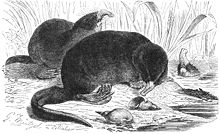Russian desman
| Russian desman | ||||||||||||
|---|---|---|---|---|---|---|---|---|---|---|---|---|

Russian desman ( Desmana moschata ) |
||||||||||||
| Systematics | ||||||||||||
|
||||||||||||
| Scientific name of the genus | ||||||||||||
| Desmana | ||||||||||||
| Güldenstädt , 1777 | ||||||||||||
| Scientific name of the species | ||||||||||||
| Desmana moschata | ||||||||||||
| ( Linnaeus , 1758) |
The Russian desman , muskrat or Wychochol ( Desmana moschata ) is a species of mammal from the mole family (Talpidae). Together with the Pyrenees Desman , he forms the group of Desmane (Desmanini), who of all moles are most strongly adapted to a water-dwelling way of life.
features
Russian desmans reach a head body length of 18 to 21 centimeters, the tail is just as long (17 to 21 centimeters) and laterally flattened. Their weight is 100 to 220 grams, which makes them the heaviest moles. The snout is elongated and very mobile, it is reminiscent of a trunk. The hind feet are webbed and additionally have bristle hairs on the sides, the front feet have smaller webbed feet. The head is characterized by the elongated, trunk-like snout, the small eyes and the ears that are almost entirely hidden in the fur. The fur is made up of a short, dense, plush undercoat and long, stiff protective hair, it is colored red-brown on the top and ash-gray on the underside. On the underside of the tail there is a scent gland from which the animals secrete a musk-like secretion.
distribution and habitat
The distribution area of the Russian Desmane extends along the Don , Volga and Urals rivers in southwestern Russia and adjacent parts of Ukraine and Kazakhstan . They were settled along the Dnepr and the Ob . Their habitat are the banks of rivers, but also lakes and ponds.
Way of life and food
Russian desmans build burrows on the bank that are only accessible from the water and end in a nest padded with leaves or moss. In contrast to many other insectivores , they live in groups, with several animals often sharing a burrow.
These animals are predominantly nocturnal, but sometimes also go looking for food during the day. This takes place in the water, where they rummage through the bottom of the water with their snout. The diet consists of insects , crustaceans , fish and amphibians .
Reproduction
Russian desmans usually reproduce twice a year, with births mostly occurring in June and November. The gestation period is around 40 to 50 days and the litter size is two to five young. These are weaned after around a month.
threat
The species was still relatively common until the end of the 19th century, after which a massive decline in populations began due to the hunt for desman's fur . They were also persecuted because of the glandular secretions used to make perfumes. In 1957, hunting was finally banned.
Today's threats are water pollution and competition from imported nutrias and muskrats . Several protected areas have been established and resettlement programs are ongoing, including on the Ob and Dnepr , where the species was previously not native. Overall, the Russian Desman is listed as endangered ( vulnerable ) by the IUCN . The total population is estimated at 40,000 to 50,000 animals. The populations declined due to fur traps, water pollution and the rivalry for common habitats with muskrats and nutrias.
literature
- Ronald M. Nowak: Walker's Mammals of the World. 2 volumes. 6th edition. The Johns Hopkins University Press, Baltimore MD et al. 1999, ISBN 0-8018-5789-9 .
Web links
- Desmana moschata in the endangered Red List species the IUCN 2006. Posted by: Insectivore Specialist Group, 1996. Retrieved on 11 May, 2006.
Individual evidence
- ↑ Desman | mammal. Retrieved November 22, 2019 .
